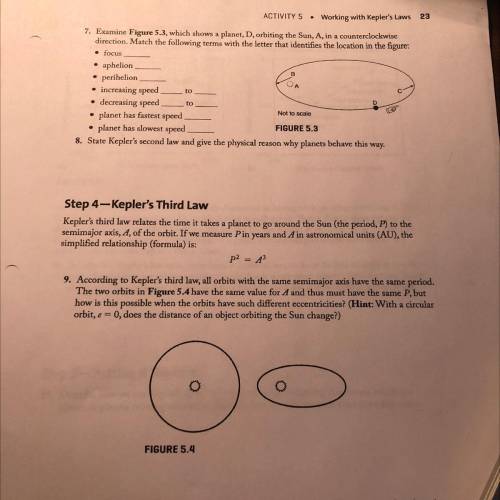ACTIVITY 5
Working with Kepler's Laws
23
B
0
7. Examine Figure 5.3, which s...

Biology, 12.02.2021 05:50, ryanez5306
ACTIVITY 5
Working with Kepler's Laws
23
B
0
7. Examine Figure 5.3, which shows a planet, D, orbiting the Sun, A, in a counterclockwise
direction. Match the following terms with the letter that identifies the location in the figure:
• focus
aphelion
perihelion
• increasing speed
• decreasing speed
planet has fastest speed
planet has slowest speed
FIGURE 5.3
8. State Kepler's second law and give the physical reason why planets behave this way.
to
to
D
Not to scale
.
Step 4-Kepler's Third Law
Kepler's third law relates the time it takes a planet to go around the Sun (the period, P) to the
semimajor axis, A, of the orbit. If we measure Pin years and A in astronomical units (AU), the
simplified relationship (formula) is:
p2 = A3
9. According to Kepler's third law, all orbits with the same semimajor axis have the same period.
The two orbits in Figure 5.4 have the same value for A and thus must have the same P, but
how is this possible when the orbits have such different eccentricities? (Hint: With a circular
orbit, e = 0, does the distance of an object orbiting the Sun change?)
FIGURE 5.4


Answers: 3
Other questions on the subject: Biology



Biology, 22.06.2019 03:40, joannachavez12345
Organisms that successfully adapt will leave to grownone of the above
Answers: 1

Biology, 22.06.2019 06:00, briana21092005
Where substance is produced during cellular respiration
Answers: 1
Do you know the correct answer?
Questions in other subjects:















